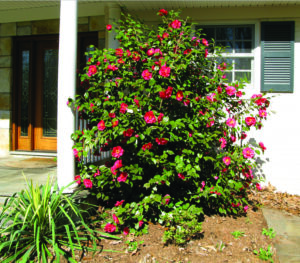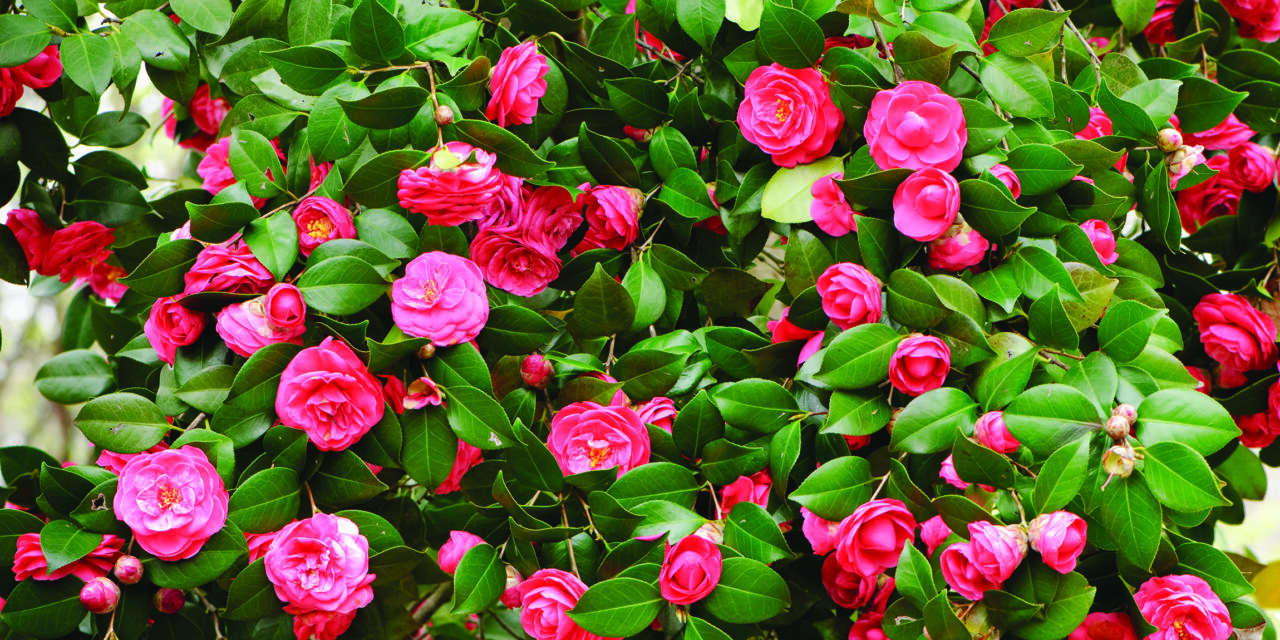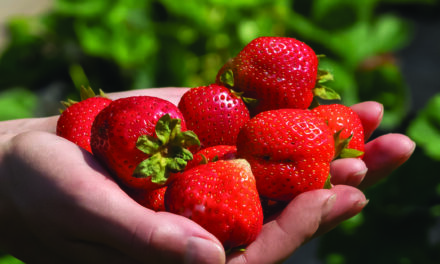
The spring-blooming Paulette Goddard camellia brings a combination of colorful blooms and a sizable plant to a landscape. (Photo courtesy Lenka Lunsten)
Camellias, originating in China and Japan, found favorably fertile ground and devoted fans in the Southern United States.
Despite being traditionally trickier to grow farther north, they remained a sentimental favorite of geographically transplanted Southern gardeners.
Eventually their glossy green foliage and elegant blooms beckoned to Mid-Atlantic flower lovers.
Such was the case for Lenka Lunsten, co-president of the Camellia Society of the Potomoc Valley (CSPV). Her unexpected love affair with the species began on a Mother’s Day visit to the National Arboretum. She became a devotee, determined to grow the striking specimens. Lunsten isn’t by any means alone in that pursuit, as evidenced by the growth of two Mid-Atlantic clubs, CSPV meeting in Washington D.C., and the Virginia Camellia Society (VCS), meeting at the Norfolk Botanical Gardens.
“From February through April, the spring bloomers show their magnificence.
In the fall, when nothing else is blooming in your yard, the fall bloomers will attract people and bees alike from late October through mid-January – or until a hard frost ends their parade.
As an added benefit, some fall bloomers are sweetly scented. During the entire year, the perennial shiny green leaves look great in the landscape,” Lunsten said. “Flower shapes vary from singles to doubles, formal doubles, peony doubles and irregulars.”
Speaking to the Potomoc Valley group in the 1980s, Jerry Hall, owner of a large camellia nursery in Alexandria, Va., recalled the initial doubt surrounding the plant’s prospects when he first became intrigued by them about 1940.
One area expeditions he encountered occasional specimens including Sarah Frost or Black Lady.
He also heard from customers who relayed conventional wisdom dispersed to them from Carolina roadside purveyors cautioning, “Oh, don’t try them up there. You can’t do it!”
But an adventurous few who didn’t listen included a former Ambassador to Japan, David Reed. After World War II, several prestigious D.C.-area garden writers began heralding the once beleaguered camellias, helping create public interest and ultimately nursery demand.
Initial success eventually confronted the onset of subsequent harsher winter seasons, spelling disaster.
Such was the case in the 1970s, when famed horticulture specialist Dr. William Ackerman oversaw their cultivation at the National Arboretum in Washington D.C.
After Ackerman’s prized specimens were dealt destructive blows during two extremely cold winters, he took up a transformative quest enabling them to be grown ultimately as far north as Nova Scotia.
According to his 2013 Washington Post obituary, Ackerman introduced roughly 50 cold-hardy varieties, derived via hand pollination of thousands of seedlings. After retiring from the National Arboretum, he continued the groundbreaking work on expanding the species seasonal reach at his seven-acre Montgomery County farm, resulting in the fall and winter blooming Ashton and Winter series. He authored, “Beyond the Camellia Belt” in 2007.
He also presided as head of the Potomoc Valley Camellia Society.
Longwood Gardens founder Pierre S. DuPont especially prized the flowers, and its Camellia House continues to showcase a variety of species. Since 1957, the Longwood has also been instrumental in creating additional hybrids helping extend its growing area.
Dr. Peter Zale, Longwood’s Associate Director of Conservation for Plants and Breeding, said they are pursuing two different goals with camellias.
The first is to continue developing camellias, which are cold hardy to at least Zone 6b.
Two such cultivars are the ‘Centennial’ and the “Valentine.”
The second goal being worked towards is to achieve everblooming
Camellias be incorporating qualities found in the Chinese Camellia Azalea, Zale added
A third, ‘Aida’ is continuing to be refined.
The Eastern Shore’s often changing mini-climates can be erratic enough to wreak havoc on those shown to grow safely into the cooler seasons of late fall or early spring.
Rachel J. Rhodes, University of Maryland Extension Master Gardener Coordinator for Queen Anne’s County, offers residents insights into weather, insect and disease challenges presented by growing camellias.
“In climates like ours (zone 7), where our winter temperatures can dip down into single digits and our springs can have those periodical late frosts it’s imperative to select a cold hardy camellia,” Rhodes said. “Arguably, the hardiest will be Camellia oleifia or Camellia japonica.
There are many cultivars of these and you can really curtail your planting to a bloom color that you love.
Look for cultivars/hybrids that will fit best in your landscape parameters.
“In most areas, it is recommended to plant Camellias in the spring (early April) for winter blooming.
However, our summers can be very dry with inconsistent rain so caring for your newly planted shrub during this time period is critical,” she added.
Prior to planting, Rhodes recommended following what she called the five crucial ‘6’s:
“Proper Planning and Preparation Prevent Poor Performance.” For camellias, this includes sizing up your intended site. Does it get enough shade? Is it out of the wind? Does it get enough sunlight? Do you have heavy or light soil?”
“Like blueberries and azaleas, camellias are acid loving plants. They do best when soil pH is between 5.0 to 6.5. If the soil pH is too high than the plant will grow poorly,” Rhodes noted. If your soil hasn’t been tested within the past three to five years, contact https://extension.umd.edu/resource/soil-testing-and-soil-testing-labs.”
Due to the prevalence of those aforementioned temperature swings, Rhodes also advised precautionary measures such as using a thermal blanket, burlap, or floating row cover to protect the plants.
“During a heavy, wet snowfall or an ice storm, it would be advisable to put a tomato cage around the newly planted shrub then drape the blanket, burlap or floating row cover over the cage. This protects the limbs from breaking,” she said.
Camellia growers should be on guard to protect the plants from Camellia leaf gall, a fungus favored by humid, moist, shady conditions, overwinters in the soil and can be splashed onto the leaves by wind.
Host-specific to camellias, it will not infect other nearby plants.
After being exposed in fall and winter, galls can form on leaves in spring becoming small bumps turning them swollen and fleshy.
After rupturing on the under sides a whitish spore masses can be seen.
Prevention and treatment include careful pruning, removing affected leaves, and keeping them dry while watering, Rhodes said.
For more information, visit www.cspv.org and www.vacamelliasociety.org.





